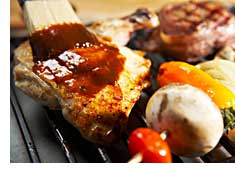 |
A Hot Sauce Guide Takes A Stand Against Bland!
|
 |
|
HOT SAUCE 101 Torrid Times Heat & Health How Hot Is Hot? The Big Chill Hall of Flame Global Warming Chile Peppers |
||
A "Hot" Sauce for Every Taste There are hundreds if not thousands of hot sauces out there. There are also almost as many varieties of fiery foods. Here are several to choose from: There are hundreds if not thousands of hot sauces out there. There are also almost as many varieties of fiery foods. Here are several to choose from:Salsas. Salsa is Spanish for sauce. The Aztecs, Mayans and Incas of present-day Mexico were dining on salsa long before Christopher Columbus discovered America. Here in the United States, salsa usually means a tomato-based sauce, but ingredients can really vary (see How to Make Salsa). The major types of traditional salsas include: salsa cruda (uncooked), picante (hot), fresca (fresh), rojo (red) and verde (green). The main ingredients for picante salsa -- what we first came to know and love in the U.S. -- are fresh cilantro, tomatoes, hot peppers (jalapenos are a favorite), onions. Back in ole Mexico, the original salsas were made from chiles, tomatillos and a blend of spices with no tomatoes. Other common ingredients include beans -- which mellow out the sauce, different kind of hot peppers (serrano, habanero), you name it. Over the years, sweet salsas incorporating fruit including mango, passion fruit, papaya and raspberries have become popular. Sambals. Ketchup is to the American hot dog as sambal is to the Indonesian kitchen table. It's the country's national condiment, but it comes in different varieties depending on the cook. Most sambals blend spices, hot chiles and other seasoning and are used from dawn until dusk. Chutneys. Another spicy relish, chutneys hail from India and are made of fruit, spices and herbs. One of my favorites is lime pickle (very pungent and spicy). Most Americans are familiar with Major Grey's Mango chutney which is a sweet rather than hot. Chutney can be made with just about any fruit or vegetable including mangos, tomatoes, apples, you name it. Jamaican Jerk Sauce. No. Jamaican Jerk wasn't created by jerk. Instead, it's most likely that the "jerk" in its name refers to food preparation. The Arawak Indians of Jamaica reportedly seasoned meat with peppers and spice and then cooked them slowly over a fire pit. Chow Chows. This is a Chinese preserve made of fruits, fruit peels or a relish consisting of chopped vegetables or picked in mustard. Learn how to make Chow-chow relish here. BBQ Sauce. Barbecue is thought to have originated in the South and was known in Virginia before the 1700s. The name came into common use in the 1800s with Western Cowboys. The story goes that the chuck wagon on long cattle drives was stocked with tough cuts like brisket. To make the brisket taste good, the cowboys and their cooks figured out that long, slow cooking over a wood fire with constant basting could turn a stringy bit of beef into an appetizing pleasure-fest. Today, backyard barbecuing is a favorite American pastime (there's even a National Barbecue Association) and BBQ sauces have numerous regional variations. Louisiana barbecue sauce is known to be hot and spicy. Kansas tends to be on the sweeter side and Californians like a sauce with a lot of smoky flavor. Buffalo Wing Sauce. A mother desperate to make a tasty snack for her son and his friends threw together a midnight snack with the ingredients she had on hand at the family bar in Buffalo, New York: chicken wings deep fried served with cayenne pepper sauce, celery and blue cheese dressing. At least that's one of the stories that the Bellisimo family tells about the origin. However it developed, buffalo wings are tasty in a large part due to the hot sauce that accompany them and, of course, over the years, many variations on the theme have developed include soy sauce based sauces. Caribbean Hot Sauces. These are usually big on fruit, sometimes contain mustard and almost always use habaneros or scotch bonnet peppers. Southwestern Hot Sauce. Usually these are built around the jalapeno. Some can be similar to Tabasco in terms of their use of vinegar. Others throw in more cumin than you'd find in hot sauce from other regions. Louisiana Hot Sauce. As personified by the great and original Tabasco, these usually feature a fermented mash of cayenne peppers, vinegar and salt. Marinades. These liquids are used to soak foods, particularly tough cuts of meat, before cooking. A marinade adds flavor and also tenderizes. Usually a key ingredient of a marinade is something acidic like vinegar or fruit juice, which helps break down the connective tissues and make the meat tender. Learn how to make a basic marinade here. Rubs. A collection of spices and herbs that are "rubbed" onto food, usually meat, before cooking. Rubs add flavor and can also make tough cuts more tender. They usually contain paprika or chili powder to add color and flavor. |
||
|
A division of Sparky Boy Enterprises Copyright © 2006. All rights reserved. |
||